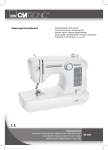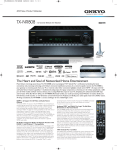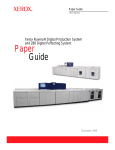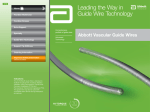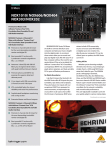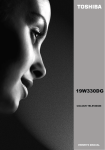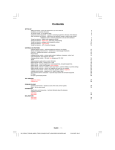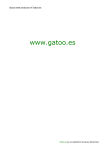Download EST Europa Style NM 600 Instruction manual
Transcript
Bedienungsanleitung/Garantie Gebruiksaanwijzing • Mode d’emploi Instrucciones de servicio • Istruzioni per l’uso Instruction Manual • Instrukcja obsługi/Gwarancja Návod k použití • Használati utasítás • Інструкція з експлуатації Руководство по эксплуатации • Nähmaschine Naaimachine • Machine à coudre • Máquina de coser • Macchina per cucire Sewing Machine • Maszyna do szycia • Šicí stroj • Varrógép Швейна машинка • Швейная машина • NM 600 DEUTSCH........................................................................................................ Seite 5 NEDERLANDS.................................................................................................... blz 13 FRANÇAIS........................................................................................................page 20 ESPAÑOL..................................................................................................... página 27 ITALIANO...................................................................................................... pagina 34 ENGLISH...........................................................................................................page 41 JĘZYK POLSKI.............................................................................................strona 47 ČESKY...........................................................................................................Strana 54 MAGYARUL......................................................................................................oldal 60 УКРАЇНСЬКА...................................................................................................стор 67 РУССКИЙ......................................................................................................... стр. 73 80 ................................................................................................................... 2 Übersicht der Bedienelemente Overzicht van de bedieningselementen • Liste des différents éléments de commande Indicación de los elementos de manejo • Elementi di comando • Overview of the Components Przegląd elementów obsługi • Přehled ovládacích prvků • A kezelőelemek áttekintése Огляд елементів управління • Обзор деталей прибора • 3 Abbildungen C - F Afbeeldingen C - F • Figures C - F • Figuras C - F • Figure C - F • Figures C - F • Rysunki C - F • Obrázky C - F • C. – F. ábrák Малюнки C - F • Рисунки C - F • C-F 4 Contents Overview of the Components..................................................3 Figures C - F................................................................................4 General Safety Instructions....................................................41 Symbols in these Instructions for Use................................41 Children and Frail Individuals..............................................41 Special Safety Instructions for this Machine.......................41 Parts description / Scope of delivery....................................42 Unpacking the machine..........................................................42 Application instructions..........................................................42 Folding table top .................................................................42 Thread reel holder ..............................................................42 Electrical connection............................................................42 Switching On / Off................................................................42 LED sewing lamp................................................................42 Choice of needle size and threads.....................................43 Operation...................................................................................43 Inserting the needle ............................................................43 Fastening and removing the presser foot shoe.................43 Threading the upper thread................................................43 Adjusting the upper thread tension . ..................................44 Inserting the bobbin thread reel .........................................44 Fetching the bobbin thread.................................................44 Winding up the bobbin .......................................................44 Stitch selection at the stitch selector...................................45 Sewing.................................................................................45 Button holes.........................................................................45 Stop operation.....................................................................45 Trouble shooting......................................................................45 Cleaning.....................................................................................46 Noise development..................................................................46 Technical Data..........................................................................46 Disposal.....................................................................................46 Meaning of the “Dustbin” Symbol.......................................46 General Safety Instructions Read the operating instructions carefully before putting the appliance into operation and keep the instructions including the warranty, the receipt and, if possible, the box with the internal packing. If you give this device to other people, please also pass on the operating instructions. • The appliance is designed exclusively for private use and for the envisaged purpose. This appliance is not fit for commercial use. • The power adaptor is only intended for use in dry environments. • Ensure that output power, voltage, and polarity of the power adapter match the specifications on the type label! • Do not touch the connected power adaptor with wet hands! • Disconnect from mains power supply before cleaning. • Ensure that the mains cable is not bent or kinked; do not walk or drive over the cable; do not subject the cable to heat sources. • The device and the mains lead have to be checked regularly for signs of damage. If damage is found the device must not be used. • Do not try to repair the appliance on your own. Always contact an authorized technician. To avoid the exposure to danger, always have a faulty cable be replaced only by the manufacturer, by our customer service or by a qualified person and with a cable of the same type. • Use only original spare parts • Pay careful attention to the following “Special Safety Instructions”. Symbols in these Instructions for Use Important information for your safety is specially marked. It is essential to comply with these instructions in order to avoid accidents and prevent damage to the machine: WARNING: This warns you of dangers to your health and indicates possible injury risks. CAUTION: This refers to possible hazards to the machine or other objects. NOTE: This highlights tips and information. Children and Frail Individuals • In order to ensure your children’s safety, please keep all packaging (plastic bags, boxes, polystyrene etc.) out of their reach. WARNING! Caution! Do not allow small children to play with the foil as there is a danger of suffocation! • This device is not intended to be used by individuals (including children) who have restricted physical, sensory or mental abilities and/or insufficient knowledge and/or experience, unless they are supervised by an individual who is responsible for their safety or have received instructions on how to use the device. • Children should be supervised at all times in order to ensure that they do not play with the device. Special Safety Instructions for this Machine WarnIng: • Always pull the plug of the foot controller out of the machine when working in the area of the needle such as threading, changing the needle, inserting the bobbin or changing the presser foot. • Use only the supplied accessories or the ones recommended in this manual. Using not recommended accessories can cause injuries. 41 CAUTION: • When turning the stitch selector (1), the needle has to be in upper position. • While sewing do neither push nor pull the fabric. This can cause the needle to break. • This sewing machine is designed only for home use. • Position the machine safely on a flat work space. • In no case use another power supply than the one delivered. • When leaving the machine, switch the machine off and pull the power supply plug out of the outlet. Parts description / Scope of delivery Overview of control elements on page 3: Figure A (front side of the machine) 1 Stitch selector 2 Bobbin winder shaft 3 Bobbin winder edge guide 4 Hand wheel 5 Stitch selector symbols 6 Electrical connection 7 Button for reverse sewing 8 Lever for loosening the presser foot shoe 9 Table top with accessory compartment 10 Presser foot 11 Presser foot fastening bolt 12 Needle fastening bolt 13 Thread cutter 14 Upper thread tension control 15 Button for loosening the thread tension 16 Thread lever 17 Needle thread feed hole 18 Thread guide for spooling Figure B (rear side of the machine) 19 Presser foot lever 20 Thread reel holder Figures on page 4: Figure C (accessories) 21 Foot controller 22 Power supply 23 Needles (2x) 24 Threading guide 25 Twin needle 26 Buttonhole foot 42 27 28 29 30 31 32 33 Needle plate elevation for bar tack and embroidery function Screw driver Thread reel holder Zipper foot Presser foot shoe Seam cutter Bobbin thread reels Without figure: Cleaning brush 100 piece sewing set Unpacking the machine 1. Take the machine out of the packaging. 2. Remove all packaging material such as foils, fillers, cable brackets and card box packaging. 3. Check the delivery for completeness. Application instructions Folding table top (Fig. D and E) Empty bobbin thread reels and other accessories are stored in the table top. 1. Pull the folding table top out horizontally (Fig. D). 2. Shift the accessory compartment lid to the right as indicated by arrow markings and open it (Fig. E). Thread reel holder (29) Take the thread reel holder out of the table top and insert it into the guide at the rear side of the machine (20). Electrical connection (Fig. F) 1. Connect the power supply plug with the machine (a). 2. Connect the power supply with a 230 V~, 50 Hz outlet installed according to regulations (b). 3. Connect the foot controller with the machine (c). 4. Set the On/Off switch to “I”. 5. The machine speed can be controlled by pressing the foot controller. Switching On / Off • Switch position “I”: Machine and LED sewing lamp on. • Switch position “ ”: off LED sewing lamp The LED sewing lamp is maintenance free and does not need any replacement. Choice of needle size and threads Needle system: Flat-shank needle system 130 Needle size 80 (12) 90 (14) 100 (16) 110 (18) Fabrics Middleweight fabrics: Cotton, satin, working clothes, canvas, double-layered fabrics, lightweight wool Middleweight fabrics: Wool, heavyweight knitwear, terry cloth, denim Heavyweight fabrics: Wool, canvas and quilted fabrics, denim, furniture fabrics (light to middle) Heavyweight: Wool, coat fabrics, furniture fabrics, some leather and vinyl (with leather needles) Thread Most threads are of middle size and adequate for these fabrics and needle sizes. For best results use polyester threads for synthetics and cotton or naturally woven fabrics. Use the same kind of thread for the upper and the bobbin thread. Heavy duty thread Fastening and removing the presser foot shoe (Fig. H – J) The machine has a standard presser foot for sewing various kinds of fabrics. For sewing button holes and zippers, you have to mount another presser foot shoe to the presser foot holder. When changing the presser foot shoe, the needle should be lifted completely. Turn the hand wheel (4) in the direction of the arrow. For replacing the presser foot shoe, see the following description with the figures H - J. 1. Fig. H: Pull the presser foot lever (19) upwards. Loosen the presser foot fastening bolt (a). Attach the presser foot holder (b) to the presser foot shaft (c) and tighten the bolt (a). 2. Fig. I: Put the presser foot shoe (d) onto the needle plate. Lower the presser foot lever (19) until the notch (e) is positioned exactly above the pin (f) of the presser foot shoe. Press lever (g) until the pin (f) locks in the notch (e). 3. Remove presser foot shoe (Fig. J): Lift presser foot lever (19), press lever (g) and the presser foot shoe drops off. Operation Inserting the needle (23) WARNING: Risk of injury! Pull the foot controller plug out of the machine before inserting the needle. NOTE: Replace the needle on a regular basis, in particular if it is bent or the tip is damaged. A bent needle causes skip stitches. Defect needle tips damage the fabric. Insert the needle in the following way: The guide of the needle has to be lifted completely. Turn the hand wheel (4) in the direction of the arrow. Loosen the needle fastening bolt (12) and tighten it again after inserting the new needle. The flat side of the needle has to face the rear side. Insert the needle until the edge guide. Threading the upper thread (Fig. K) For quick and easy installation of the upper threads, follow steps 1 to 7, according to the dashed line of figure K below and/ or follow the arrows on the machine. 1. Set the thread reel onto the thread reel holder (20) and guide the thread through the needle thread feed hole (17) from back to front. 2. Push the button for releasing the thread tension (15) to the left, then guide the thread down and make sure that the thread is positioned between the tension discs and release the button (15). 3. Pull the thread upwards on the left side of the thread lever (16). 4. Insert the thread into the thread lever and guide it down again on the right side of the thread lever. 5. Insert the thread through the thread guide eye from front to back. 6. Insert the thread through the needle thread guide from top to bottom. 7. Finally, insert the thread into the needle from front to back (important !!!!). 43 Adjusting the upper thread tension (14) The basic setting is between 4 and 5. Depending on fabric and thread size, adjust by turning the control (14) so that the knot of the upper and the bobbin thread can be recognized as a spot on the upper side of the fabric. If you see loops the thread tension is too loose. Inserting the bobbin thread reel (Fig. L) 1. When inserting or removing the bobbin thread reel (33), the needle has to be lifted completely. Turn the hand wheel (4) in the direction of the arrow. 2. Pull off the table top horizontally from the machine. Pull the transparent looper cover out towards the front. 3. Insert the bobbin into the looper, having the reel turning clockwise (see right Fig. on the looper cover). Let 5 cm of the thread stay out. 4. Slide in again the looper cover. 44 Fetching the bobbin thread 1. Lift the presser foot (10), hold the upper thread with your left hand and turn the hand wheel with the right hand in the direction of the arrow until the needle has arrived at the top again (one complete turn of the hand wheel). 2. Pull the upper and the bobbin thread 10 cm towards the back. You can use scissors for this, for example. Winding up the bobbin (Fig. M and N) caution: Remove the upper thread completely out of the machine. Otherwise, it would wind around the inner parts and block the machine. note: You control the amount of the bobbin thread to be wound up by turning the bobbin winder edge guide (3). To the left: less thread on the reel. 1. Place an empty reel (33) onto the bobbin winder shaft (2). 2. Place a thread reel onto the thread reel holder (20). 3. Guide the thread via the thread guide (18) to the empty reel. 4. Clockwise, wind up the thread several times around the empty reel. 5. Push the reel against the bobbin winder edge guide (3). 6. Start the winding by pressing the foot controller. 7. When the reel is filled, the winding stops automatically. If you want to stop the winding earlier, release the foot controller. 8. Cut the thread and remove the reel. Stitch selection at the stitch selector (1) 16 stitch types can be chosen. 1. The needle has to be lifted completely. Turn the hand wheel (4) in the direction of the arrow. 2. Set the stitch selector to the desired setting. Pay attention that the stitch selector is locking into the desired position. Sewing 1. Make sure that the bobbin winder shaft (2) is set to “SEWING”. 2. Lift presser foot and pull upper and bobbin thread towards the back (approx. 10 cm). 3. Place the fabric underneath the presser foot. 4. Lower the presser foot onto the fabric. 5. Slowly activate foot controller to begin sewing. Guide the fabric manually in a successive manner. 6. Press the button for reverse sewing (7) to sew a bar tack at the end of a seam or in the middle of a seam. Releasing the button, the machine sews forward again. 7. At the end of the seam, stop the needle in the upper position to facilitate easy removal of the thread. 8. Lift the presser foot and remove the fabric. 9. Move the threads over the thread cutter in order to cut them (13). Button holes Preparation: Insert the button hole foot 1. The needle has to be lifted completely. Turn the hand wheel (4) in the direction of the arrow. 2. Lift the presser foot lever (19), remove the presser foot shoe by pressing the lever (g) and replace it by the button hole foot (see “Fastening and removing the presser foot shoe (Fig. H – J)”). The red scale of the button hole foot has to be on the left side. 3. Determine the button diameter and add 3 mm (1/8”) for the button hole bar tack. For a very thick button, add more to the diameter. 4. Mark position and length of the button hole on the fabric. 5. Position the fabric in a way that the needle is located at the rear left side of the button hole. 6. Pull the button hole foot towards the front as far as possible. 7. Bring the foot down. Button hole sewing: caution: When turning the stitch selector (1), the needle always has to be in the upper position. 1. Set the stitch selector to program no. 13. Sew the left button hole seam with appropriate speed until the front mark. 2. Set the stitch selector to program no. 14 and sew 5-6 bar tacks. 3. Set the stitch selector to program no. 15 and sew the right button hole seam until the upper mark (beginning of the button hole). 4. Set the stitch selector to program no. 16. Finally, sew again 5-6 bar tacks. 5. Remove the fabric underneath the foot. Pull the upper thread through the back side of the fabric and interlace upper and bobbin thread to prevent unintentional dissolving. 6. Cut the middle of the button hole with the seam cutter (32). Pay attention that the seam on both sides will not be damaged. Stop operation 1. Set the On/Off switch to “ ” to switch off machine and sewing lamp. 2. Pull the power supply out of the outlet. 3. Pull the plug of the foot controller out of the machine. Trouble shooting Problem Upper thread breaks Bobbin thread breaks Potential cause The machine is not threaded correctly. Thread tension is too high. The thread is too thick for the needle. The needle is not inserted properly. The needle is damaged. The bobbin thread reel is not inserted properly. Upper thread tension is too loose. Correction New threading of the machine. Loosen the thread tension (lower number). Choose a bigger needle. Remove the needle and insert it again (flat side to the rear). Replace the needle. Check the position of the reel. Adjust upper thread tension (higher number). 45 Problem Skip stitches Needle breaks Loose stitches Kinking seam Potential cause The needle is not inserted properly. Needle is damaged. The wrong needle size has been used. Presser foot is not fastened correctly. Needle is damaged. The needle is not inserted properly. Wrong needle size for the fabric. Presser foot is not fastened correctly. Machine is not threaded correctly. The bobbin thread reel is not inserted properly. Wrong combination of needle/fabric/ thread. Wrong thread tension. The needle is too big for the fabric. The stitch length is set wrongly. Thread tension is too high. Correction Remove the needle and insert it again (flat side to the rear). Insert a new needle. Choose a needle that is adequate for thread and fabric. Check position of the presser foot and fasten it correctly. Insert a new needle. Insert the needle correctly (flat side to the rear). Choose a needle that is adequate for thread and fabric. Check position of the presser foot and fasten it correctly. Check threading. Insert the bobbin thread reel as shown on the looper cover. Cleaning This device has been tested according to all relevant current CE guidelines, such as electromagnetic compatibility and low voltage directives, and has been constructed in accordance with the latest safety regulations. WARNING: • Always detach the machine from the power supply before cleaning! • In no case submerge the machine and the power supply in water for cleaning. This could cause electrical shock or fire. CAUTION: • Do not use a wire brush or other abrasive objects. • Do not use aggressive or abrasive cleaning agents. • Use a dust cloth for outside cleaning of the housing. • Clean the area underneath the looper cover with a dry brush. Noise development The sound pressure level in the ear of an operator (LpA) was measured according to DIN EN ISO 3744. Sound pressure level detected: 80 dB(A) (no limit) Technical Data Model:................................................................................NM 600 Sewing area illumination..............................................LED 0.5 W Net weight:............................................................ approx. 3.20 kg Power Adaptor Protection class:........................................................................... II Input:.......................................................AC 100-240 V, 50/60 Hz Output:............................................................. DC 12 V, 1500 mA Polarity:........................................................................... Subject to technical changes without prior notice! 46 The needle size has to be adequate for fabric and thread (see table). Correct thread tension. Choose a finer needle. Adjust the stitch length again. Loosen thread tension (lower number). Disposal Meaning of the “Dustbin” Symbol Protect our environment: do not dispose of electrical equipment in the domestic waste. Please return any electrical equipment that you will no longer use to the collection points provided for their disposal. This helps avoid the potential effects of incorrect disposal on the environment and human health. This will contribute to the recycling and other forms of reutilisation of electrical and electronic equipment. Information concerning where the equipment can be disposed of can be obtained from your local authority.










